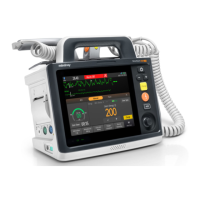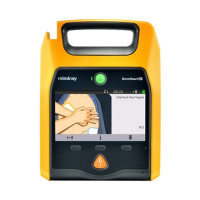11 - 2
11.3.2 Applying ECG Electrodes
• Store the electrodes at room temperature.
• Only open the electrode package immediately prior to use.
• Never mix patient electrode types or brands. This may lead to problem due to impedance mismatch.
• When applying the electrodes, avoid bony area, obvious layers of fat, and major muscles. Muscle
movement can result in electrical interference. Applying electrodes on major muscles, for example
on muscles of the thorax, may lead to erroneous arrhythmia alarms due to excessive muscle
movement.
11.3.3 Electrode Color Coding
• For the 5-lead electrode placement, place the precordial electrode according to the physician's
preference.
• To reduce the hazard of burns during use of electrosurgical units (ESU), the ECG electrodes should
not be located between the surgical site and the ESU return electrode.
• Never entangle the ESU cable and the ECG cable together.
• If the ESU is used, do not place ECG electrodes near the grounding plate of the ESU. Otherwise
interference on ECG signals may occur.
11.3.4 Checking Paced Status
• When monitoring a patient implanted with a pacemaker, be sure to select correct paced status.
Otherwise, the pace pulses may be counted in the case of cardiac arrest or some arrhythmias. Do not
completely rely on the heart rate reading or the heart rate alarms. Always keep paced patients under
close surveillance.
• For paced patients, set Paced to Yes. Otherwise the monitor could mistake a pace pulse for a QRS
complex and fail to generate alarm when the ECG signal is too weak. On ventricular paced patients,
episodes of ventricular tachycardia may not always be detected.Do not rely entirely upon the
system’s automated arrhythmia detection algorithm.
• False low heart rate or false asystole alarms may result with certain pacemakers because of
pacemaker artifacts, such as electrical overshoot of the pacemaker overlapping the true QRS
complexes.
• Do not rely entirely on heart rate meter alarms when monitoring patients with pacemakers. Always
keep these patients under close surveillance.
• For non-paced patients, you must set Paced to No.
11.3.5 Setting the Switch of Pacer Rejection
• When pace pulses are detected, the pace pulse marks “|” are shown on the ECG waveforms. Pacer
Rejection setting has no impact on the display of pace pulse marks “|”.
• You can switch on pacer rejection only when Paced is set to Yes. If Paced is set to no, the setting of
Pacer Reject is disabled.

